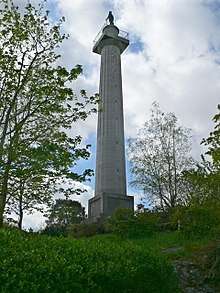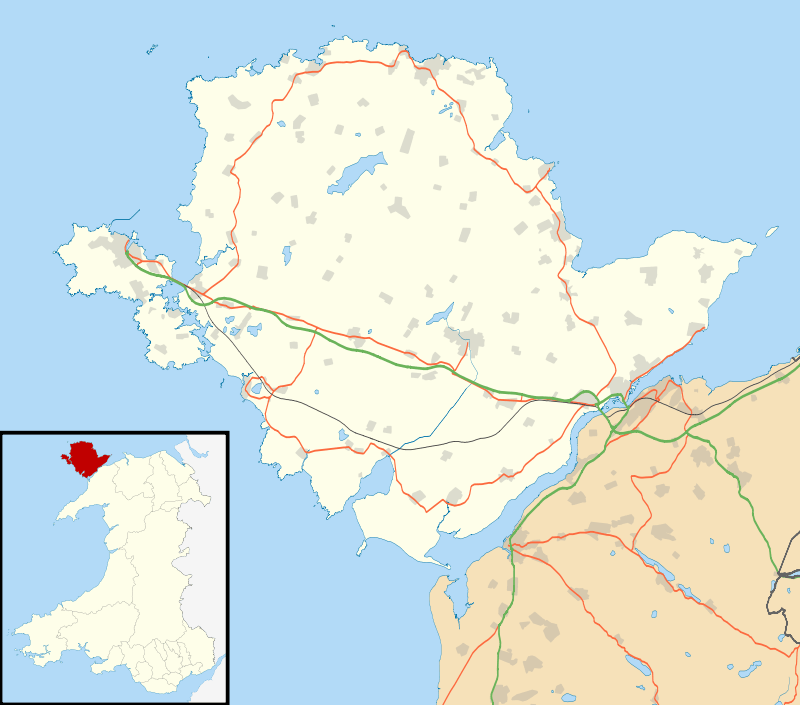Marquess of Anglesey's Column
The Marquess of Anglesey's Column (also known as Anglesey Column or by the Welsh name Tŵr Marcwis) is a Doric column near the Menai Strait in Wales. It is dedicated to Henry William Paget (the first Marquess of Anglesey) to commemorate his valour in the Napoleonic Wars. The column is a Grade II* listed building.[1]
| Marquess of Anglesey's Column | |
|---|---|
 | |
| Type | Monument |
| Location | Anglesey, Wales |
| Coordinates | 53.2208°N 4.1967°W |
| OS grid reference | SH 5343 7156 |
| Built | 1817 |
Listed Building – Grade II* | |
| Official name: Anglesey Column | |
| Designated | 5 February 1952 |
| Reference no. | 5432 |
| Community | Llanfair Pwllgwyngyll |
| Principal area | Isle of Anglesey |
 Location of Marquess of Anglesey's Column in Anglesey | |
The 27-metre (89 ft) high monument (designed by Thomas Harrison) was erected close to Paget's country retreat at Plas Newydd, in 1817.[2] On the foundation stone there is an inscription, which also reads in Welsh and Latin;
The inhabitants of the counties of Anglesey and Caernarvon have erected this column in grateful commemoration of the distinguished military achievements of their countryman HENRY WILLIAM, MARQUESS OF ANGLESEY the leader of the British Cavalry in Spain throughout the arduous Campaign of 1807 and Second in Command of the Armies confederated against France at the memorable battle of Waterloo on the 18th of June 1815. Thomas Harrison Architect.
During the battle of Waterloo, Paget (at that time Lord Uxbridge) lost his leg to a cannonball hit. It is claimed he turned to Lord Wellington when his leg was hit, and exclaimed, "By God, sir, I've lost my leg!" — to which Wellington replied, "By God, sir, so you have!".[3] Paget was later fitted with the first ever articulated wooden leg.[3]
The column stands on an outcrop of blueschist rock, formed when pillow lavas have been metamorphosed under high pressure but relatively low temperature. This example is amongst the oldest known in the world, and in 2010 the site was declared a Geological Site of Special Scientific Interest.[4]
Statue
The monument was not completed until 1860 (after the Marquess had died) when the brass sculpture at the top was added. Matthew Noble sculpted the statue.[1]
Present Condition
In recent years, the condition of the column has deteriorated. Many of the wooden steps in the tower have rotted, and pose a severe fire risk. As a result, the column closed to the public in March 2012, with no formal restoration proposals agreed.The last 'Column Keeper' was Mr David Blackmore who lived in the cottage and took care of the site for 20 years.
In 2018, £60,000 funding from the National Lottery was awarded towards restoring the column. [5]
References
- "Anglesey Column". Statutory List of Buildings. Cadw. 21 April 1998 [Listed 1952]. Cadw Building ID 5432. Retrieved 2 May 2016 – via Historic Wales.
- "The Marquess of Anglesey's Column & Nelson's Monument". Places to visit. Retrieved 2 May 2016.
- "Obituary: The 7th Marquis of Anglesey". The Telegraph. 15 July 2013. Retrieved 22 February 2014.
- "Anglesey rocks given special status". BBC News. BBC. 9 November 2010. Retrieved 3 June 2019.
- "Marquess of Anglesey's Column project gets boost". BBC News. 2018.